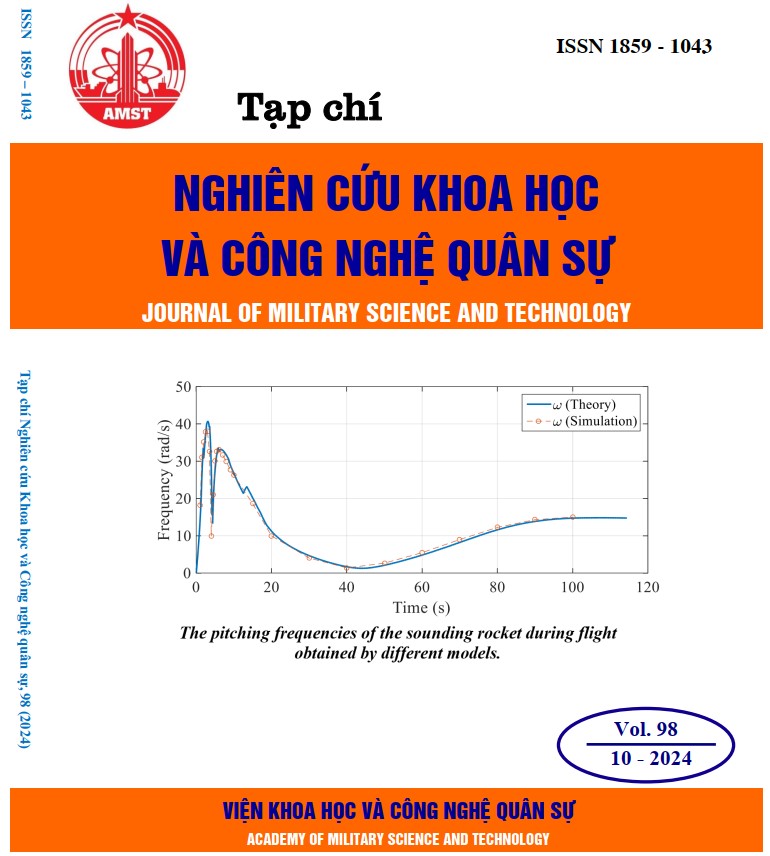Synthesis of controllers based on linear matrix inequalities for a magnetic levitation system
367 viewsDOI:
https://doi.org/10.54939/1859-1043.j.mst.98.2024.61-68Keywords:
Magnetic levitation system; Linear Matrix Inequalities (LMIs); Integral-state feedback control; Sliding mode control; Nonlinear mathematical model.Abstract
This paper presents the results of synthesizing controllers based on Linear Matrix Inequalities (LMIs) for a magnetic levitation system with a strongly nonlinear mathematical model: integral-state feedback control and sliding mode control. Comparative simulation results and evaluations of the controllers in MATLAB/Simulink software have demonstrated that the controllers perform well and are robust to changes in the mass of the object, with the object's position closely following the setpoint signal. However, in cases where system parameters change significantly, the control system with the integral-state feedback controller may operate inaccurately or even become unstable, whereas the sliding mode controller still ensures stability and robustness against changes in system parameters
References
[1]. Cho D, Kato Y, Spilman D. “Sliding mode and classical control of magnetic levitation systems”. IEEE Control Syst Mag; 13(1):42–8, (1993). DOI: https://doi.org/10.1109/37.184792
[2]. Jayawant B. V., Sinha P. K., Aylwin D. G. “Feedback Control System for D.C. Electromagnets in Passenger-Carrying Vehicles”. Int J Control; 24(5):627–39, (1976). DOI: https://doi.org/10.1080/00207177608932851
[3]. Chamraz, Š.; Huba, M.; Žáková, K. “Stabilization of the Magnetic Levitation System”. Appl. Sci., 11, 10369, (2021). https://doi.org/10.3390/app112110369 DOI: https://doi.org/10.3390/app112110369
[4]. Hajjaji and M. Ouladsine, “Modeling and nonlinear control of magnetic levitation systems”, IEEE Transactions on Industrial Electronics 48, no. 4, 831–838, (2001). DOI: https://doi.org/10.1109/41.937416
[5]. R. Uswarman, A. I. Cahyadi and O. Wahyunggoro. “Control of a magnetic levitation system using feedback linearization”. 2013 International Conference on Computer, Control, Informatics and Its Applications, Jakarta, Indonesia, pp. 95-98, (2013). DOI: https://doi.org/10.1109/IC3INA.2013.6819156
[6]. B. Liu and W. Zhou. “Backstepping Based Nonlinear Adaptive Control of Magnetic Levitation System with Unknown Disturbances”. 2013 5th International Conference on Intelligent Human-Machine Systems and Cybernetics, Hangzhou, China, pp. 11-14, (2013). DOI: https://doi.org/10.1109/IHMSC.2013.9
[7]. Li J. H, Li J., Yu P. C, Wang L. C. “Adaptive backstepping control for levitation system with load uncertainties and external disturbances”. J. Cent. South Univ. 21, 4478–4488 (2014). DOI: https://doi.org/10.1007/s11771-014-2451-0
[8]. M. Lepetic, I. Skrjanc, H. G. Chiacchiarini and D. Matko. “Predictive control based on fuzzy model: a case study”. 10th IEEE International Conference on Fuzzy Systems. Melbourne, VIC, Australia, pp. 868-871 vol.3, (2001). DOI: https://doi.org/10.1109/FUZZ.2001.1009093
[9]. M. Jalili-Kharaajoo, M. M. Tousi, H. Bagherzadeh and A. E. Ashari. “Sliding mode control of voltage-controlled magnetic levitation systems”. Proceedings of 2003 IEEE Conference on Control Applications, 2003. CCA 2003., Istanbul, Turkey, pp. 83-86 vol.1, (2003). DOI: https://doi.org/10.1109/CCA.2003.1223267
[10]. Hafiz M., Syed A., Iftikhar A., Ali S. “Nonlinear adaptive control of magnetic levitation system using terminal sliding mode and integral backstepping sliding mode controllers”. ISA transactions 126, 121–133, (2022). DOI: https://doi.org/10.1016/j.isatra.2021.07.026
[11]. Pratik Vernekar, Vitthal Bandal. “Robust Sliding Mode Control of a Magnetic Levitation System: Continuous-Time and Discrete-Time Approaches”, Research Square, (2021). https://doi.org/10.21203/rs.3.rs-1011817/v1 DOI: https://doi.org/10.31224/osf.io/nqfyz
[12]. S. Boyd, L. El-Ghaoui, E. Feron, and V. Balakrishnan. “Linear Matrix Inequalities in System and Control Theory”. Philadelphia, PA: SIAM, (1994). DOI: https://doi.org/10.1137/1.9781611970777







